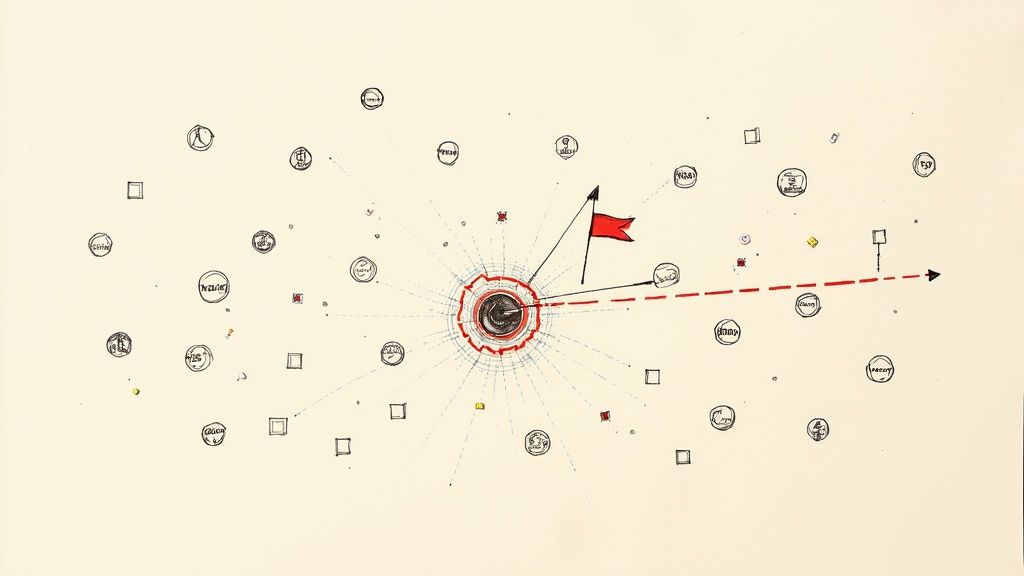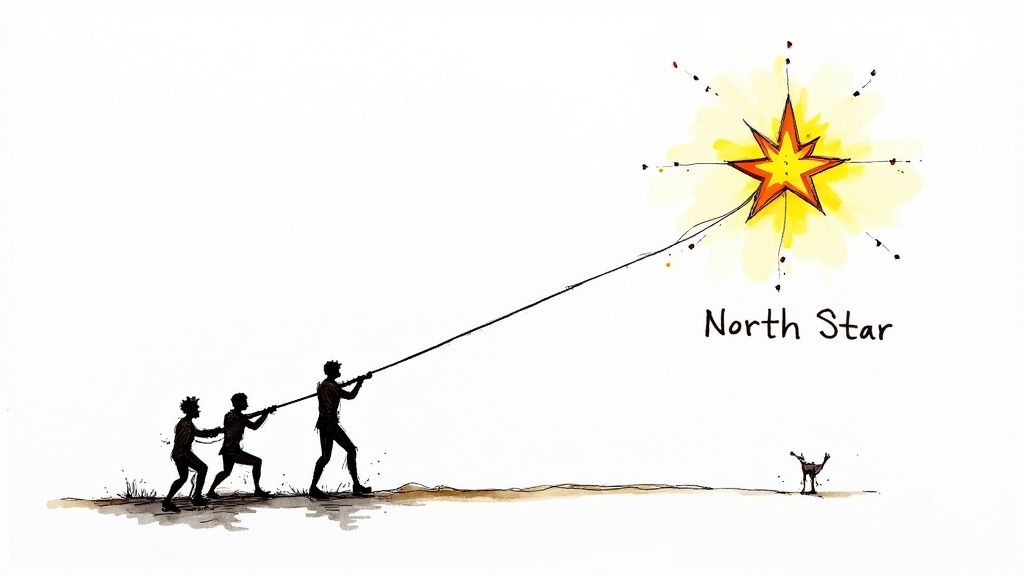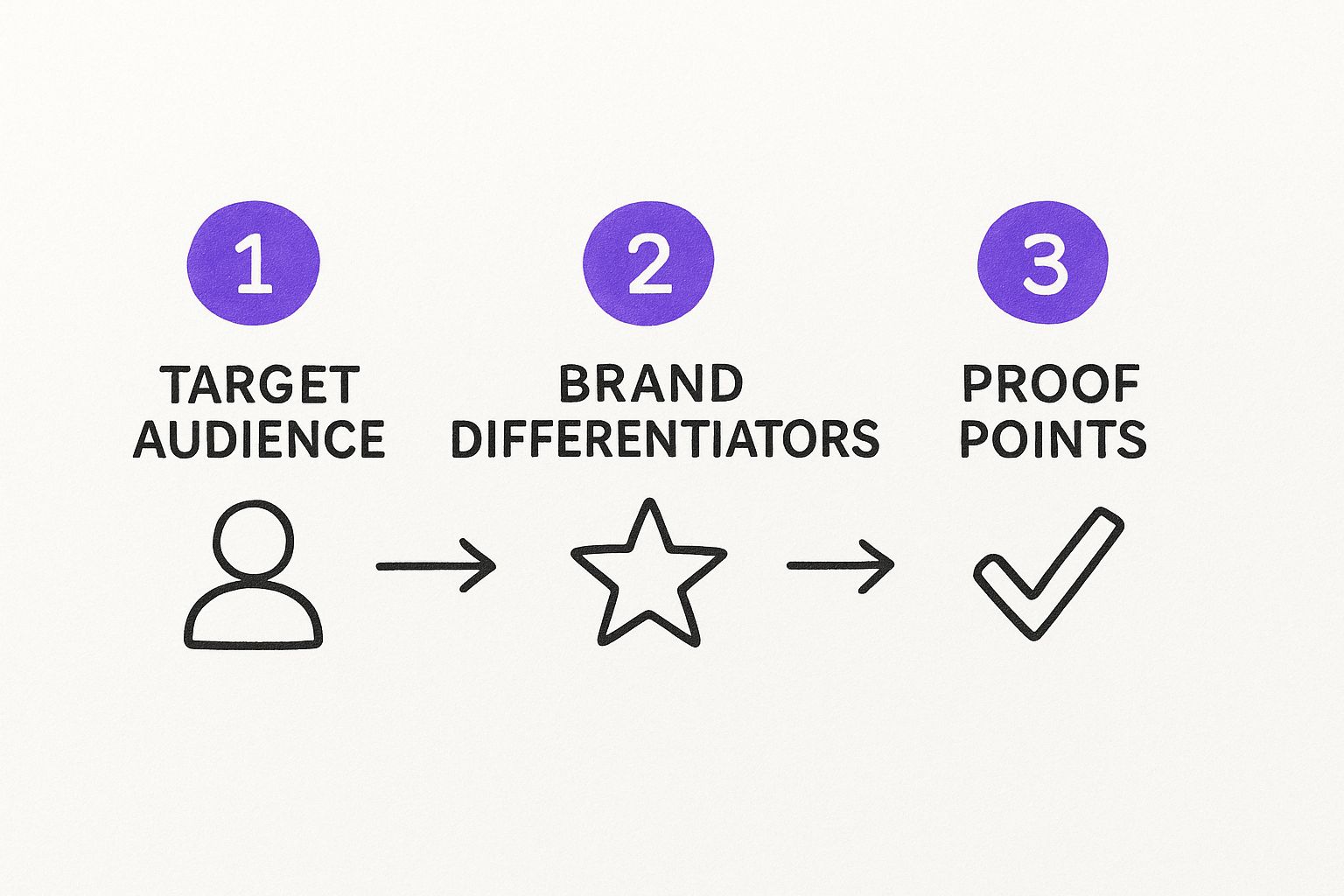Build a Winning Competitive Positioning Framework
Learn to build a competitive positioning framework that makes your brand stand out, attracts ideal customers, and drives serious business growth.

A competitive positioning framework is your game plan for standing out in a crowded market. Think of it like trying to find an open spot on a packed beach—it shows you where everyone else has their towels, so you can claim the best patch of sand and have customers seek you out on purpose.
So, What Exactly Is a Competitive Positioning Framework?

Let's cut the business jargon. A competitive positioning framework isn't some mythical scroll locked in a CEO's office. It’s a simple tool that helps you figure out how your brand is different—and better—for a very specific group of people.
It all boils down to answering one question: "Why should a customer pick me over everyone else?"
If your answer is a vague, "Uh, because we're better," you don't have a strategy; you have a wish. This framework forces you to get brutally honest about what truly makes you unique. Instead of trying to be everything to everyone (a classic recipe for disaster), a good framework helps you pick your battles. It’s the difference between shouting into a hurricane and whispering the perfect solution to someone who’s been desperately looking for it.
Why You Absolutely Cannot Just Wing It
Without a clear plan, your business just drifts. Marketing throws money at random tactics that don't connect. Sales teams trip over their words trying to explain what you actually do. And your product team? They end up building features nobody asked for. It’s expensive chaos.
A solid framework gets everyone rowing in the same direction. It turns that chaos into a coordinated effort, ensuring every decision—from a single tweet to a multi-million dollar product launch—reinforces the same core message about your brand.
This isn’t some new-fangled idea. The concept of mapping out your market position goes way back. Its history traces back to models like Michael Porter's work in the 1980s, which introduced strategies like cost leadership and differentiation. These ideas were later expanded on with tools like the Bowman Strategy Clock, giving businesses more nuanced options. You can find more insights on the evolution of strategic thinking if you're into that sort of thing.
The Core Components of a Positioning Framework
To get this right, you need to know the essential building blocks. Each piece is critical for creating a position that’s not just unique, but also defensible and super compelling to your customers.
| Component | What It Actually Means | Why It's a Game-Changer | | :--- | :--- | :--- | | Target Audience | Who is your ideal customer, really? Get specific. | Stops you from wasting cash trying to sell to your mom's friend's cousin. | | Market Category | What "box" does your customer put you in? | Defines your rivals and sets customer expectations. | | Brand Differentiators | What’s your "secret sauce"? | The real reason they'll choose you over the other guys. | | Key Benefits | How do you make their life less awful? | People don't buy features; they buy solutions to their problems. | | Supporting Evidence | How can you prove you're not full of it? | Testimonials, data, and case studies build trust and shut down doubt. |
Think of these as ingredients in a recipe. Miss one, and the whole thing tastes off. When they all work together, you create something your target audience will find irresistible.
The Ultimate Goal: Own a Piece of Your Customer's Mind
At the end of the day, this whole exercise is about carving out a specific "position" in your customer's brain. When they think about the problem you solve, your brand should be the first—and best—one that pops into their head.
> A brand with a strong position doesn't just compete; it becomes the obvious choice. It stops selling and starts attracting.
This mental real estate is incredibly valuable. It’s why some brands can charge a fortune while others are stuck in a race to the bottom on price. The framework is your blueprint for building that perception on purpose, instead of just leaving it to chance.
So, Why Is This Framework Your Secret Weapon?

Is a competitive positioning framework just another buzzword consultants made up? Nope. It’s what separates the businesses that win from those that are always playing catch-up.
Think of it as your company’s North Star.
Without one, your teams are flying blind. Marketing burns cash on ads that miss the mark. Sales struggles to explain why you're better. Product adds features nobody wants. It's a chaotic, expensive mess.
But with a solid framework? Everyone gets on the same page. Random acts of marketing turn into a focused strategy where every move reinforces what makes you unique. This isn't just about looking good in a PowerPoint; it's about making smarter decisions that boost your bottom line.
Stop Wasting Money and Start Attracting the Right People
One of the biggest perks of a clear positioning strategy is that it acts like a powerful filter. When you know exactly who you are for, you stop trying to be everything to everyone.
This focus is a massive budget-saver. You stop pouring marketing dollars down the drain on people who were never going to buy from you anyway.
Instead, you start attracting perfect-fit customers. These are the people who not only buy what you're selling but become your biggest fans. They get your value instantly because you’re speaking their language.
> Your brand positioning statement is the internal compass that guides how your brand is perceived. While customers won't see it, it's the North Star for all your marketing strategies and messages.
Suddenly, everything gets easier. Your content clicks, your ad copy writes itself, and your sales team has better conversations. You're no longer just an option; you're the option.
Defend Your Turf and Set Your Prices with Confidence
A strong position is like building a moat around your business. When you own a spot in the customer's mind—whether it's "the easiest to use" or "the best for small teams"—it's incredibly tough for competitors to attack you.
Of course, to build that moat, you have to know what your rivals are up to. This means digging into what is competitive intelligence and weaving it into your strategy. Tools like Ahrefs or Semrush are powerful, but they can be expensive. A platform like already.dev is a great alternative, giving you the competitive data you need without the eye-watering price tag.
This framework also lets you stop competing on price. When your value is crystal clear, you can step out of that brutal race to the bottom.
Here's how:
- You compete on value, not cost. People happily pay more when they understand the unique benefit they're getting.
- It justifies premium pricing. Strong brands command higher prices because their perceived value is higher.
- It makes selling easier. Your team can confidently explain your price, backed by a value proposition that just makes sense.
A competitive positioning framework is the quiet hero behind the brands that seem to dominate their categories effortlessly. It's the strategic bedrock that lets them build a loyal following and grow for the long haul.
The Four Pillars of a Winning Strategy
Alright, let's get into the good stuff. A powerful competitive positioning framework isn’t a bunch of abstract ideas; it’s built on four solid pillars. Get these right, and you’ve got a foundation that can withstand anything.
Think of it like building a house. You wouldn't just start throwing up walls on some dirt, right? These four pillars are that foundation.
Pillar 1: Your Target Audience
This is the most important one, and it's where most companies get lazy. "Our product is for everyone" is a business plan for going broke. You need to get so specific about your ideal customer that you can picture them ordering their morning coffee.
Who are they really? What keeps them up at night? What silly memes do they send their friends? The more you know, the better you can position your product as the only solution that "gets" them. Nailing your product market fit strategies is crucial here, as it’s the bedrock of how your offering connects with real people.
This deep understanding stops you from shouting into the void and helps you whisper the right message directly into the right ear.
Pillar 2: Your Market Category
This is about defining the "game" you're playing. When a customer is looking for a solution like yours, what mental box do they put you in? Are you a "budget project management tool," a "luxury electric vehicle," or a "quick and healthy lunch spot"?
Defining your market category clarifies who you’re really up against. If you position yourself as a premium coffee brand, you're not competing with the instant coffee on aisle five; you're fighting the local artisanal cafe.
> Choosing your category is choosing your competitors. It defines the battlefield so you can pick a fight you know you can win.
Get it wrong, and you'll be stuck explaining what you are instead of proving why you're better.
Pillar 3: Your Brand Differentiators
This is where you answer the million-dollar question: "What makes you so special?" And no, "we have great customer service" isn't a good answer—that's the bare minimum.
Your differentiators must be specific, meaningful to your audience, and hard for competitors to copy. They are your secret sauce.
- A unique feature? Maybe you have an AI-powered widget no one else has.
- Your business model? Think of TOMS Shoes' "one-for-one" model.
- Your brand's personality? Look at how Wendy's uses sassy social media to stand out.
To see how this works visually, check out a perceptual map showing brands plotted by different attributes.

This kind of map instantly shows where a brand has carved out a unique spot or where the market is overcrowded. You can get a deeper look into building your own in our guide to the marketing positioning matrix.
Pillar 4: Your Proof Points
This last pillar is all about trust. You can make all the amazing claims you want, but if you can't back them up, you're just making noise. Proof points are the evidence that turns your bold claims into believable facts.
These aren't just fluffy testimonials; they are concrete reasons for customers to believe you.
- Case Studies: Show, don't just tell. Detailed stories of customer success are gold.
- Data and Statistics: "Our software helps teams save an average of 10 hours per week."
- Awards and Certifications: Third-party validation builds instant credibility.
- Customer Reviews: A firehose of positive, authentic reviews is social proof in action.
These four pillars work together. It starts with the customer, flows into what makes you unique, and finishes with the proof that seals the deal. Get them right, and you've built a brand that can truly compete.
How to Build Your Framework Step by Step

Okay, theory's done. Time to roll up our sleeves and build this thing. Creating a competitive positioning framework isn’t some dark art; it’s a practical process of asking the right questions and doing some smart digging.
This isn't about creating a hundred-page document nobody will read. The goal is a simple, powerful guide that helps you make better decisions every single day. Let's do it.
Step 1: Start With Some Competitor Spying
Before you can figure out where you stand, you need to know who else is on the field. This step is all about competitor research—but don't worry, you don’t need a trench coat and a fake mustache.
The foundation of this whole process is a thorough competitive landscape analysis to get the lay of the land. This means finding not just the obvious players, but also the indirect competitors and up-and-comers who could sneak up on you.
> A huge mistake is only looking at your direct competitors. Sometimes the biggest threat comes from a company in a totally different category that solves the same underlying problem.
To get the real dirt, you'll need some tools.
Your Competitor Analysis Toolkit
Finding the right tools can feel overwhelming. Big platforms are powerful but can cost a fortune.
| Tool Type | Expensive Option (e.g., Semrush) | Affordable Alternative (already.dev) | What You Can Uncover | | :--- | :--- | :--- | :--- | | Competitive Intelligence | Comprehensive but costly suites. | Focused, cost-effective platform. | Hidden competitors, market trends, feature gaps, customer sentiment. |
While tools like Semrush are fantastic, they can be really expensive. A platform like already.dev gives you deep competitive intelligence without that financial headache, helping you uncover rivals you didn't even know you had.
Step 2: Map the Market
Once you have your list of competitors, it’s time to create a "perceptual map." This sounds more complicated than it is. It's basically a simple chart that helps you visualize where everyone stands so you can spot an open lane for your brand.
Here’s how:
- Pick Two Key Dimensions: Choose two factors that matter most to customers in your industry. This could be Price vs. Quality, Simplicity vs. Features, or even Modern vs. Traditional.
- Draw Your Axes: Create a simple graph with one dimension on the X-axis and the other on the Y-axis.
- Plot Your Competitors: Place each competitor on the map. Is Mailchimp simple and affordable? Is HubSpot complex and expensive? Put them where they belong based on public perception.
- Find the Gap: Step back and look for the empty space. Is there an opening for a tool that's both simple and has advanced features? That empty quadrant is your opportunity.
This visual exercise is incredibly powerful. It cuts through the noise and shows you exactly where to position your brand. If you want a more structured way to organize your findings, our competitive analysis template can be a huge help.
Step 3: Define Your Unique Value Proposition
You've found your gap in the market. Awesome. Now it's time to define what makes you the perfect fit for that spot. This is your Unique Value Proposition (UVP). It’s a short, punchy statement explaining the benefit you offer, who you offer it to, and how you do it better.
A simple formula to get you started is: For [your target audience] who [have a specific need], our product is a [your market category] that provides [your key benefit]. Unlike [your main competitor], we [your key differentiator].
Filling this out forces you to be brutally clear. It’s the "elevator pitch" for your entire company.
Step 4: Craft Your Positioning Statement
The final step is to polish your UVP into a clean, memorable positioning statement. This becomes your company's internal mantra—the North Star that guides every marketing, sales, and product decision.
A great positioning statement is:
- Simple and memorable: Everyone in the company should be able to recite it.
- Distinctive: It has to clearly set you apart.
- Credible: It has to be a promise you can actually deliver.
This isn't just a fluffy marketing exercise. Getting this right has a real, measurable impact. Companies that use a systematic framework like this report roughly 15-25% higher customer retention rates and 10-20% greater revenue growth. A clear position isn't just nice to have; it's a direct driver of success.
By following these steps, you move from guessing to knowing. You create a solid position that attracts the right customers and gives your entire team the clarity it needs to win.
Positioning Strategies from Real-World Brands
https://www.youtube.com/embed/6lqq_pEv3ko
All this theory is great, but a competitive positioning framework only really clicks when you see it in the wild. Let's look at how real brands use these principles to win. You'll see they didn't just stumble into success; they made a deliberate choice about where to play and how to win.
Southwest Airlines: The Unbeatable Low-Cost King
Southwest didn't just join the airline industry; it blew up a corner of it. For decades, flying was this semi-luxurious thing. Southwest looked at that and said, "Nah, let's make it more like a bus... but in the sky."
Their positioning is brilliantly simple.
-
Target Audience: Budget-conscious travelers who care more about getting from Point A to B cheaply than they do about in-flight peanuts.
-
Key Differentiator: Low cost. This isn't just a marketing slogan; it's baked into their DNA. They only fly one type of plane (Boeing 737) to simplify maintenance. No assigned seats gets planes boarded faster. And no fees for the first two checked bags is a massive jab at their nickel-and-diming competitors.
-
Reinforcement: Every single thing they do reinforces this position. Their marketing is fun and down-to-earth. Their stock ticker is literally LUV. They built a brand that feels friendly, not stuffy.
> By focusing maniacally on low cost, Southwest became the champ of a specific market. They don't try to be the best airline; they try to be the best low-cost airline.
Rolex: The Apex of Aspirational Luxury
Now, let's rocket to the opposite end of the spectrum. Rolex doesn't sell watches; they sell status and achievement. You don't buy a Rolex to tell time—your phone does that better. You buy a Rolex to show the world you've arrived.
This is a masterclass in premium positioning.
-
Target Audience: High-net-worth individuals, collectors, and people who view a watch as a milestone purchase. The audience isn't just rich; they are achievement-oriented.
-
Key Differentiator: Perfection and heritage. Rolex relentlessly talks about craftsmanship, from the custom alloys they create to the years of testing each watch endures. They sponsor elite events like Wimbledon and Formula 1, connecting their brand with excellence.
-
Reinforcement: Even their pricing is part of their positioning. The high cost and intentional scarcity create an aura of exclusivity. You will never, ever find a Rolex on sale. This ensures that owning one feels like joining a very exclusive club.
Chobani: Creating a New Category
Before Chobani, yogurt in the US was mostly sugary, watery kid stuff. Greek yogurt was a niche concept. Chobani didn't just try to compete in the yogurt aisle; they basically created the Greek yogurt category and then dominated it.
-
Target Audience: Health-conscious people hunting for high-protein food that wasn't boring. They appealed to consumers who were actually reading labels.
-
Key Differentiator: Authenticity and health. Chobani positioned itself as "real" Greek yogurt with "only natural ingredients." This was a huge difference from the processed options on the shelves. Plus, their immigrant-founder story resonated with people tired of faceless corporations.
-
Reinforcement: Their simple, clean packaging stood out. They used their "Chobani Food Philosophy" to communicate a clear commitment to quality. By focusing on a specific product attribute (thick, high-protein) and a clear value (natural and healthy), they carved out a massive space in a market everyone thought was full.
Common Mistakes That Can Wreck Your Strategy
Alright, you’ve got a beautiful framework. But here's the thing: the hard part isn't building it; it's making sure it doesn't just gather digital dust or completely fall flat.
A few classic blunders can torpedo the whole effort. Let's walk through the most common traps so you can steer clear of them.
The "We're for Everybody" Trap
This is, hands down, the biggest strategy killer. It’s so tempting to cast a wide net. But when you try to appeal to everyone, you end up connecting with no one. Your message becomes generic, watered-down, and forgettable.
Trying to be everything to everyone makes you nothing to anyone. A strong competitive positioning framework is about making tough choices. It means having the guts to say "no" to some people so you can become the go-to solution for the right people.
> The second your positioning tries to please the entire market, it loses all its power. It's the fastest way to become background noise.
Making Promises Your Product Can't Keep
Here's another classic: crafting a positioning statement that sounds incredible but doesn't line up with reality. If you claim to be "the simplest solution on the market," your user experience better be an absolute cakewalk.
When there's a gap between what you say and what you do, you don’t just lose a sale—you create an anti-fan. Trust evaporates instantly, and they'll tell their friends. Your positioning has to be rooted in truth.
Picking a Fight with the Wrong Giant
I get it. It’s a great David vs. Goliath story to position your startup against the 800-pound gorilla in the industry. But more often than not, it’s a fight you can’t win, especially on their home turf.
A smarter approach is to change the game. Find a niche the big players overlook or build your brand around a value they can't easily copy. Instead of trying to be a cheaper, weaker version of the market leader, be something completely different for a specific group of people. Your framework should point you toward open space, not a brick wall.
A Few Lingering Questions? Let's Clear Them Up
Still have a couple of questions? Good. Let's tackle the most common ones so you can move forward with total confidence.
How Often Should I Revisit My Framework?
This is a big one. Don't create this document and then let it die in a folder. Think of it as a living guide.
At a minimum, review it once a year. But you’ll also want to pull it out anytime something big happens. A new competitor crashes the party? Customer needs take a sharp turn? You're launching a major new product? All of these are triggers for a refresh. Honestly, a quick health check every quarter is an even better habit.
Can a Small Business Really Use This Against Big Companies?
Not only can you, but you absolutely should. This framework is one of the most powerful tools a smaller business has. Big corporations often have to water down their message to appeal to everyone, and that creates openings.
As a smaller, more nimble company, you can use your framework to laser-focus on a specific, underserved niche and completely own it.
> Smart positioning isn't about having the deepest pockets. It’s about being more clever, more focused, and meaning more to a specific group of people the giants are overlooking.
What's the Difference Between Brand Strategy and Positioning?
It's easy to get these two tangled up. Here’s a simple way to think about it:
Your brand strategy is the whole shebang. It's your company’s personality, your mission, your core values—the entire promise you make to your customers.
Your competitive positioning framework is a sharp, tactical tool within that bigger brand strategy. It’s the part that spells out exactly how you’re different and better than the other guys in the mind of your perfect customer. In short, your positioning is what proves your brand promise is true.
Ready to stop guessing and start winning? Building a killer framework starts with having solid competitive intelligence. Instead of shelling out a fortune for complex tools like Ahrefs or Semrush, let already.dev do the heavy lifting for you. Uncover your real competitors, find gaps in the market, and get the data you need to position your brand for success—all in just a few minutes. Start your free trial at https://already.dev and see what your competition is really up to.